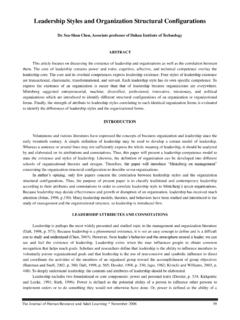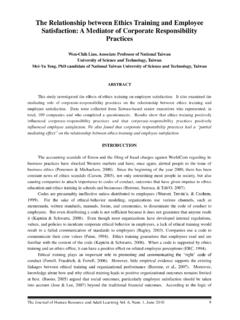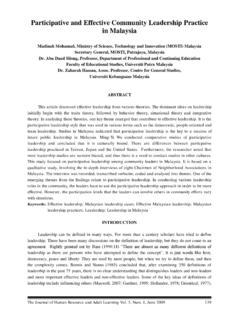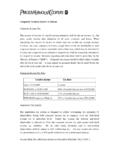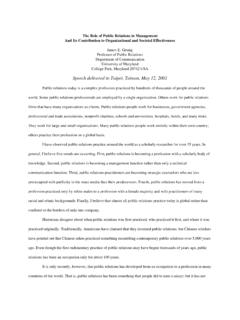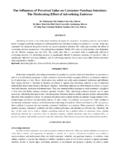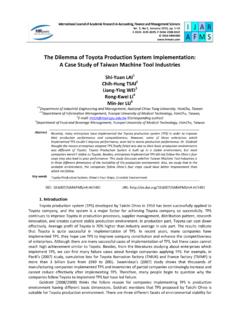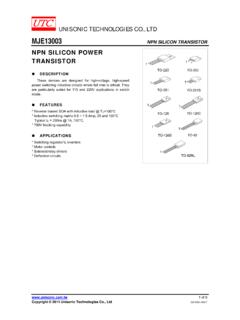Transcription of A Study on the Impact of Customer Lifetime Value …
1 A Study on the Impact of Customer Lifetime Value on Shareholder Value in taiwan 's Credit Card Market Chen Chang, PhD, Lecturer, Department of Public Finance, Jinwen University of Science and Technology, taiwan ABSTRACT. It has been a difficult but critical subject, academically and practically, for a public corporation to estimate Customer Lifetime Value (CLV) by way of sorting out and interpreting open information in stock market. taiwan and its credit card market are selected to explore above topic in this paper. The prospective link between CLV and shareholder Value is distinguished to help management and academics to assess CLV comprehensively. INTRODUCTION. The goal of the company is to deliver Value to investors (Knight, 1998). According to Fornell (2000), in 1970 the book Value for the companies in the Dow Jones Industrial Average accounted for about 50 percent of their market Value .
2 In 1999, only 20 percent of market Value was being accounted for in the balance sheet, with the remaining 80 percent consisting of intangible assets. Elsewhere, Doyle (2000) indicates, the market-to-book ratio in Britain's largest companies averages three, suggesting that two-thirds of the market Value of these companies lies in intangible assets. Market-based assets such as customers and channels are intangibles assets that must be cultivated and leveraged and should be seen as a principal bridge between marketing and shareholder Value . The emerging trend suggests that the purpose of marketing is creating and managing market-based assets to deliver shareholder Value (Srivastava et al., 1998, Doyle, 2000). Hogan et al. (2002) suggest that Customer equity is a means of growing shareholder Value . But, conventional accounting has treated marketing expenditures as costs rather than investments in intangible assets.
3 Market-based assets do not normally appear on the balance sheet because accountants believe that their Value cannot be measured with sufficient accuracy, , those assets are treated as costs rather than investments. They will not be depreciated, which may lead to insufficient spending on developing brands, retaining customers and creating channel partnerships (Doyle, 2000). Srivastava et al.(1998) established a framework linking the contribution of market-based assets to market performance and to enhance the financial performance (measured by shareholder Value ) of firms. The authors mentioned that the Value of a firm is based on expectations of future performance, so that resources allocated to marketing strategies should be viewed as investments that create assets and which can be leveraged to enhance future performance, provide potential for growth, or reduce risk.
4 Shareholder Value is not based on accounting conventions; instead it is derived on cash basis. Expenditure on developing marketing assets would make sense if the sum of the discounted net cash flow generated by the expenditures is positive. According to Rappaport (1998), the free cash flow (FCF) is influenced by seven Value drivers: sales growth, return on sales (operating profit margin), income tax rate, incremental investments in fixed and working capital, weighted average cost of capital, and the Value The Journal of Human Resource and Adult Learning Vol. 4, Num. 2, December 2008 25. growth duration. However, only the first two Value drivers, sales growth and operating profit margin, are of an operative nature. Yet even these metrics lack a direct linkage to the critical factor Customer as the source of Value creation.
5 These drivers originate from a too high aggregation level and are not suitable for the exact prediction of Customer profitability in heterogeneous markets. Both the CLV and the SHV draw on discounting forecasted net cash flows by the risk-adjusted cost of capital and both account for a comparably long forecast horizon. While the SHV belongs to the category of financial valuation methods and is therefore, located on a high, strategic level of aggregation, the CLV concept-due to its origin-is situated on the operative management level (Hoekstra and Huizingh, 1999). LITERATURE REVIEWS. The CLV Concept It views customers as a company's most important asset, since ultimately cash flows are based on Customer -generated revenues and the investments made to generate those revenues. Therefore, to continuously grow total company cash flows, a company must, therefore, continuously increase Customer -generated cash flows (Hansotia, 2002).
6 All of the definitions of CLV from academics can be summarized as the sum of the Lifetime Value of its current and future Customer (Dwyer, 1997, Berger and Nasr, 1998, Hogan et al., 2002, Jain and Singh, 2002, Gupta et al., 2004 and Pfeifer et al., 2005). The benefit from CLV calculations is two-fold: understanding the potential Value of customers and prompting firms to learn more about the patterns of individuals or groups of customers. This information allows the firm to devise optimal strategies for each Customer , eliminate wasteful costs, and create a long-term perspective of the potential relationship with customers. Firms can tailor strategies to deal with different Customer segments that exhibit differences in buying characteristics at any given time, and they can also customize different strategies for the same Customer depending on the stage of relationship between the Customer and the firm.
7 In other words, the main benefit derived from the CLV analysis is that the manager can take advantage of the analysis of results to predict the future profitability of customers and make more appropriate marketing strategies and decisions relating to customers (Gurau and Ranchhod, 2002). The Customer Lifetime Value models offer insights in managing existing Customer base. For example, classifying customers into high, medium, and low Value customers not only allows differentiation of product/service according to expected Customer Value , but provides an objective basis to direct retention efforts toward high Value customers. In addition, CLV can be used to develop a profile of high Value customers which can then be applied to a prospect list to make Customer acquisition efforts more efficient and effective (Hansotia and Wang, 1997).
8 Many ways have been proposed for measuring CLV since the articles by Dwyer (1989) and Berger and Nasr (1998). The required data and skill include: (1) datasets with specific time span and content are a must; (2) statistical techniques must be used to forecast and model future Customer behavior in terms of spending frequency, spending rate, and how long the Customer will patronize the firm; (3) analysts need to fully comprehend the limitations of the models used and implications of the assumptions built into the CLV models. Many models have been developed for determining the CLV. All of them have different assumptions under different backgrounds. Nevertheless, two basic steps for evaluating CLV can be concluded as following: (1) project the net cash flows that the firm expects to receive from the Customer over time; (2) calculate the present Value of that stream of cash flows.
9 So far, no generally accepted superior CLV evaluation approach exists (Jain and Singh, 2002). 26 The Journal of Human Resource and Adult Learning Vol. 4, Num. 2, December 2008. The Shareholder Value Concept Maximizing shareholder wealth is an important goal of any investor-owned organization. The way in which shareholder wealth is increased is by maximizing the difference between an organization's total market Value and the amount of capital that investors have supplied to the organization. This difference is called market Value added (MVA) and is expressed by the equation: MVA = total market Value total capital supplied. (Total market Value is the sum of the book Value of debt and the market Value of equity, while total capital supplied is the sum of the book values of debt and equity). However, there are some reasons which the MVA is not practical as an internal performance measure: (1) operating units do not usually have share prices or market-determined valuations; (2) not all companies are publicly traded; and (3) market values are subject to significant market volatility that may be unrelated to the operating decisions of management (Uyemura et al.)
10 , 1996). However, unlike MVA, the measure of economic Value added (EVA) does not focus directly on market values and, therefore, can be applied both to investor-owned organizations and not-for-profit organizations. The performance measure Economic Value Added has trademarked as EVA by the Stern Stewart & Co., a New York consulting firm. Stern Stewart argues that the key test of all management actions is whether or not they contribute to the creation of owners' wealth. The formula for EVA is: EVA. = operating profit total capital supplied x cost of capital. This says the company is earning $5 million more in profit than is required to cover all costs, including the opportunity cost of trying up scare capital on the balance sheet. The formula can also be shown as: EVA (ROIC WACC) Invested Capital (ROIC: return on invested capital; WACC: weighted average cost of capital).
